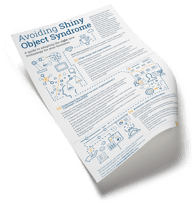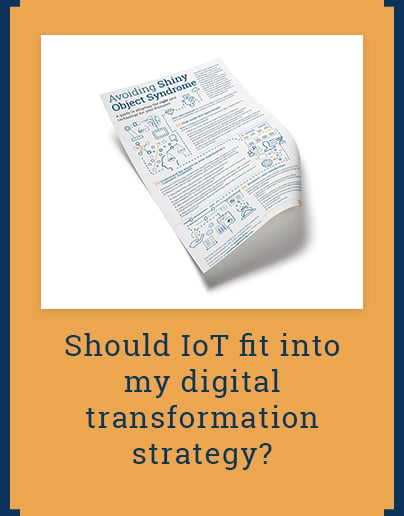With every new digital innovation comes the question, “How does this fit this into my current digital transformation (DX) efforts?” The internet of things (IoT) trend brings this question into unique focus as it offers the ability to digitize any thing.

Download our guide to adopting the right new technology.
IoT holds tremendous promise of innovation for many industries and organizations are scrambling to add IoT technologies to their internal and external digital transformation efforts. But before barging down the IoT path, the question should not be “how quickly can we introduce IoT into our business?” but rather “Why do we want to introduce IoT into our business?” or “How can we introduce IoT in a relevant way that will enhance our business models?”
IoT is transformational, and we see clients inspired by the connectedness that IoT can facilitate; however, in spite of all the hype around the many successes, there are also many quiet failures. According to Cisco, only 40% of IoT initiatives make it from pilot to production and only 26% of companies called at least one of their IoT initiatives a complete success
For many organizations, the possibility of connecting all things can quickly cloud their focus and become a hurdle to the relevance of their digital transformation initiatives. Therefore, the adoption of IoT, even more so than other emerging technologies, requires an explicit strategy.
"Connected [technologies] can't be
prescribed, they have to be discovered"
-Ben Elmore, CEO, Intevity
The Questions to Ask Pre-IoT
Before investing in IoT solutions, there are a few questions to ask:
- What sort of value should we expect, based upon investment?
- What types of experiences do we want for our customers?
- Are there any existing IoT models (and corresponding opportunities) we can explore that might work for our business?
- Given that IoT is still in relatively early adoption, how can our organization reduce risk as we discover what will work for us?
Through the lens of your customer
Ultimately, every digital initiative you undertake needs to happen through the lens of your customer. This includes your IoT initiatives. Knowing that IoT is going to make a radical change, you will want to ensure that your plan and your investment are the right ones. How can you hit it out of the ballpark the first time?
What the past has taught us
As with the many digital trends before IoT, once success stories become prevalent everyone wants in on the trend and fast. When mobile apps first came on the scene every business wanted to “go mobile.” Organizations were focused on speed – how quickly can we make an application mobile? In reality, organizations needed to be asking themselves, “why do we want to do this? What are we trying to solve for?”
As new technologies rise, people start to connect with the constraints that are lifted and want the promised freedom of the new technology, even if they didn’t want it before. When a lot of technologies are in their infancy, we don’t always see them through the lens of the business problem they can really solve.
People got excited about mobile because they suddenly had continual access. You were no longer tied to your desktop or your laptop. Initially, many of us assumed that people would use an app on their phones the same way they would use it on a desktop. But that was not the case.
People spend an hour on a desktop where they might only spend a couple of minutes on a phone. In the beginning of mobile apps, businesses tried to make these apps full-functioning, when instead they simply needed to address how that app might be used. For example, if someone was sitting in a coffee shop waiting for a friend, they might have two minutes. Hence, they needed a two-minute task that they could reliably perform on their phone.
Mobile technology has matured over the years and there are now more use cases for our phones. But in the beginning, the belief was that going mobile was simply taking an existing desktop app and making it phone-ready without thinking why or how the users would engage.
Similarly today with IoT, rather than simply adopting the technology to an organization's current systems, it should be given its own process within the system that makes sense for users.
